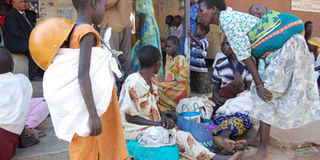Prime
What needs to change for child marriage to end

What you need to know:
At the celebration of the Day of the African Child, a strategy was launched to end child marriages and teenage pregnancies. We look at the major causes and how it can be curbed.
With the introduction of free Universal Primary Education, it was hoped that girls, especially in the rural areas, would be kept in school longer.
But with the instances of defilement and parents reaching out-of-court settlements with the defiler of their young daughters, early marriages are on the rise.
According to a 2013 Guttmacher Institute Report on Unintended Pregnancy and Abortion in Uganda, more than 90 per cent of the teenage pregnancies are among girls who are married before the age of 18.
Defilement leading to marriage
Sylvia Nalwada had her first baby when she was 15 years old. At the time, she was in Primary Five at Bbale Primary School in Kayunga District, and her boyfriend was a 27-year-old man, who had just completed his Senior Four.
“My parents reported a crime of defilement at Kayunga Police Station. He was arrested but his parents talked to the police, who released him after a few days.”
The young man visited Nalwada’s home with gifts to pacify her parents and asked to marry her. Without her consent, Nalwada was married off to a man almost twice her age.
According to the 2011 Uganda Demographic Health Survey, 14 per cent of young women had their first sexual encounter before the age of 15 while 57 per cent of young women had their first encounter before the age of 18.
On the Day of the African Child, held on June 16, the government launched the National Strategy to end Child Marriage and Teenage Pregnancy.
Developed by the Ministry of Gender, Labour and Social Development with support from Unicef, the strategy outlines approaches and interventions that will end child marriage and teenage pregnancy in Uganda.
Need to increase caretaker’s awareness
Noeline Kirabo, executive director, Kyusa, an organisation that provides soft employment skills to young people in urban slums, says most of the interventions, by the government and civil society, neglect to include the caretaker or parents of the teenagers. “We need community intervention programmes targeted at caretakers if there is going to be a reverse in the statistics of teenage pregnancies and child marriages.”
In urban slums, most adults are small income earners who work odd hours to make ends meet. Finding time to attend community intervention programmes could prove to be hard.
“It is a cycle that can only be broken with a change in the mindset,” says Kirabo. “A girl raised by a teenage, single mother will be psychologically independent. If she gets pregnant before marriage, it may not be a big deal. After all, her mother did it and survived. This mindset can only be changed if the mother is made aware of the fact that she made a mistake. Only then can she advise her daughters to concentrate on their studies.”
The need for sex education
Teenagers need to be given the opportunity to learn sex education to empower them with the information to make informed decisions.
In some families, a parent talking to their children about sex is taboo. The girls hear about sex from educators but these are outsiders who might not have an impact.
Kirabo adds: “in Kawempe, the red light district is growing because girls as young as 12 years are being pushed into prostitution by their mothers so that they can provide for the home.”
Aisha Namazzi, 17, left an abusive marriage six months ago. Namazzi and her boyfriend (later husband) were in the same school when she got pregnant last year. He was 17 years old at the time.
“My ssenga told me to go and live with him. He also left school and became a taxi conductor. Although his family treated me well, he used to beat me all the time.”
Luckily, when she walked out of the marriage, her mother-in-law paid Namazzi’s school fees for a certificate course in hairdressing.
Currently, she is looking for a job in a salon to support her daughter.
The only way this cycle can break is if the mindset of the parents is changed. This change will then flow to the girls. And while a number of legal instruments have been ratified by the government to protect the fundamental right of children not to be married before the age of 18 more needs to be done to ensure they are adhered to.
Poverty as a driving force
Sandra Nakato was 17 years old and in Primary Six last year, when her father threw her out of the family home. She says her stepmothers mistreated her and used not to provide for her.
“Together with my twin, we found men who provided for our necessities.”
When their father found out, he chased them out of his home. Babirye went to live with one of the men while Nakato went to Kampala to find work.
“When I came back to the village, I got a boyfriend who was a farmer. When I got pregnant, he took me to live with his mother in Pallisa District.”
In the home, there was almost no food. And when her labour began, her mother-in-law refused to take her to hospital.
“Her sister forced her to take me to hospital. We got a bodaboda but along the way, I felt the baby coming. They thought I was lying so they told me to get off the motorcycle and rode off. I gave birth by the roadside on my own.”
When they came back after an hour, Nakato had failed to cut the umbilical cord. It was the bodaboda rider who helped her.
Nakato left her husband’s home after he got another wife. She has now completed a certificate course in hairdressing.
“I want to work but if I get a chance of another marriage, I will take it. I need the extra money to support my child.”
What they are exposed to
Early child marriages do not only cut short a girl’s chances at education, they also expose her to the risk of contracting HIV and complications related to childbirth.
And because of poverty in the home, a girl may be forced to give sexual favours to an older man who can take care of her needs.
Adolescents from poor households are more likely to become victims of child marriages more than those in well to do families.
“The concern of a parent in the rural areas is if the man is capable of taking care of their child,” says Kirabo. “If he can, then they feel that the rest does not matter.”




